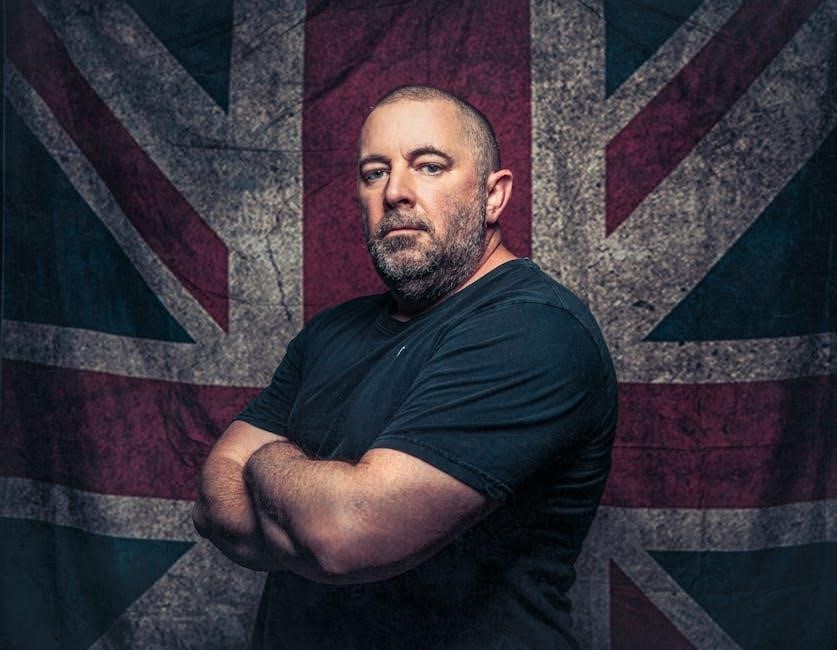Welcome to our comprehensive Heroic Halfus Wyrmbreaker guide! This guide is designed to help raid teams conquer the challenging encounter in Bastion of Twilight. Assuming familiarity with the normal mode, this guide focuses on the unique mechanics, strategies, and tips required to succeed in Heroic difficulty. Here, you’ll find detailed insights into the fight’s complexities, ensuring your team is well-prepared for victory.
1.1 Overview of the Encounter
The Heroic Halfus Wyrmbreaker encounter is a challenging and dynamic fight in Bastion of Twilight. In Heroic mode, all five drakes are active from the start, significantly increasing the complexity and difficulty. Each drake grants Halfus unique abilities and debuffs, such as Malevolent Strikes and Dragon Revenge, which must be carefully managed. The fight requires precise coordination, as the drakes are chained but will be released over time, altering Halfus’s behavior. Raiders must handle high AoE damage, manage debuffs, and maintain focus on both Halfus and the drakes. This encounter demands a well-rounded raid composition, with healers, tanks, and DPS working in harmony to overcome the intense mechanics and secure victory.
1.2 Importance of the Guide
This guide is essential for raid teams aiming to conquer the Heroic Halfus Wyrmbreaker encounter, as it breaks down the fight’s intricate mechanics and strategies. In Heroic mode, the encounter introduces additional challenges, such as managing multiple drakes and their unique debuffs simultaneously. The guide provides critical insights into optimizing raid composition, handling high AoE damage, and coordinating team efforts. It also highlights key differences from the normal mode, ensuring players are prepared for the increased difficulty. Whether you’re a seasoned raider or new to Heroic content, this guide offers invaluable tips and strategies to help your team overcome the complex mechanics and emerge victorious, making it a must-read for a successful encounter.

Encounter Overview
The Heroic Halfus Wyrmbreaker encounter pits your raid against a formidable foe and his five drakes, each granting unique abilities that significantly alter the fight’s dynamics. In Heroic mode, all five drakes are active simultaneously, introducing complex mechanics that demand precise coordination and adaptability. The encounter requires careful management of the drakes’ abilities, which empower Halfus and create challenging conditions for the raid. This overview sets the stage for understanding the fight’s core elements and prepares your team to tackle the intense battle ahead.
2.1 Basic Mechanics
In Heroic Halfus Wyrmbreaker, the encounter begins with all five drakes active, each empowering Halfus with unique abilities. The fight revolves around managing these abilities, which significantly impact both the raid and the boss. Key mechanics include debuffs like Malevolent Strikes, which reduce healing effectiveness, and Dragon Revenge, increasing Halfus’ damage taken. Additionally, the drakes’ abilities, such as Cyclonic Winds slowing spellcasting and Furious Roar dealing massive AoE damage, must be carefully mitigated. The raid must also contend with Fireball Barrage and Scorching Breath, requiring precise positioning and movement. These mechanics create a dynamic and challenging environment, demanding constant awareness and quick reactions to avoid wipes and secure victory.
2.2 Role of the Drakes
In Heroic Halfus Wyrmbreaker, the five drakes play a pivotal role in shaping the encounter. Each drake, when released, grants Halfus unique abilities that significantly alter the fight dynamics. The Storm Rider introduces Cyclonic Winds, slowing Halfus’ spellcasting, while the Time Warden enables Temporal Delay, affecting fireball speed. The Nether Successor causes Abyssal Blindness, reducing Halfus’ attack efficiency, and the Slate Dragon applies Stone Touch, potentially paralyzing targets. Lastly, the Emerald Hatchling inflicts Atrophic Poison, diminishing damage output. Each drake’s release triggers specific mechanics, forcing the raid to adapt strategies to counter these abilities effectively and maintain control over the encounter’s progression.

Understanding Abilities
This section provides a detailed breakdown of each ability, explaining their mechanics, effects, and how they impact the encounter. Understanding these is crucial for strategy development.

3.1 Malevolent Strikes
Malevolent Strikes are a critical ability in the Heroic Halfus encounter, earned through the Slate Dragon. Each strike reduces healing effectiveness on the target by 6%, stacking up to a maximum of 5 times. This mechanic demands precise tank rotation, as the accumulating debuff can lead to rapid tank death if not managed. Tanks must coordinate to swap targets every 4-5 stacks to allow the debuff to fade. Healers must remain vigilant, as the reduced healing effectiveness significantly increases the difficulty of keeping tanks alive. Discipline Priests can excel here by utilizing Power Word: Shield and Flash Heal to mitigate the damage. Proper rotation and healing coordination are essential to survive this mechanic.
3.2 Frenzied Assault
Frenzied Assault is an ability granted to Halfus by the Nether Successor drake, increasing his attack speed by 120%. This makes Halfus’s melee attacks significantly faster and more dangerous, especially when combined with Malevolent Strikes. Tanks must be prepared for the increased damage intake, and healers should prioritize healing the active tank during this phase. The raid should focus on defeating the Nether Successor quickly to remove this debilitating effect. If left unchecked, Frenzied Assault can overwhelm the tank, leading to a potential wipe. Proper drake prioritization and healer coordination are crucial to managing this ability effectively. This mechanic highlights the importance of a well-organized team and quick reactions to mitigate the increased damage output.
3.3 Shadow Nova
Shadow Nova is a devastating ability unleashed by Halfus, dealing massive Shadow damage to the entire raid while knocking players down. This ability is granted by the Storm Rider drake and becomes active once the drake is released. The damage is consistent and unavoidable, making it a high-priority mechanic to manage. Healers must be prepared to rapidly heal the raid following each Shadow Nova cast, while players should ensure they are within healing range. The periodic nature of this ability requires constant vigilance, as failing to manage it can lead to raid-wide wipes. Proper positioning and cooldown usage by healers are crucial to mitigating the impact of Shadow Nova throughout the encounter.

3.4 Furious Roar
Furious Roar is a high-damage ability that Halfus unleashes periodically, dealing significant physical damage to all nearby enemies and knocking them down. This ability becomes particularly dangerous in Heroic mode, where the increased damage output from multiple active drakes amplifies its impact. Players must be prepared to handle the sudden burst of damage, especially the tank, who will bear the brunt of the attack. Healers should be alert and ready to respond with strong cooldowns to stabilize the raid. The knockdown effect also disrupts positioning, requiring quick adjustments to avoid further complications. Furious Roar is a critical mechanic that demands careful monitoring and proactive healing to prevent unnecessary wipes. Its timing and execution make it a pivotal moment in the encounter.
3.5 Fireball Barrage
Fireball Barrage is an ability granted to Halfus by the Time Warden drake, causing him to unleash a volley of fireballs at random targets. Each fireball deals significant damage and can chain to nearby players, making it crucial for the raid to stay spread out. This mechanic is particularly dangerous in Heroic mode, where the increased damage from active drakes amplifies the Barrage’s impact. Players must remain vigilant and quickly move away from others when targeted. Healers should be prepared to respond with area-of-effect heals, while the raid focuses on eliminating the Time Warden to remove this ability. Proper positioning and awareness are key to mitigating the damage from Fireball Barrage and maintaining raid stability.
3.6 Scorching Breath
Scorching Breath is a high-damage ability used by Halfus, inflicted upon players in his frontal cone. This ability is empowered by the Orphan Emerald Hatchlings and deals continuous Fire damage to all targets in its path; In Heroic mode, the damage from Scorching Breath is significantly increased, making it a critical mechanic to manage. The tank must ensure Halfus is facing away from the raid to prevent unnecessary damage. Healers should be prepared to provide consistent healing to the tank and any players caught in the breath. Proper positioning and awareness are essential to mitigate the impact of this ability, as it can quickly overwhelm the tank if not handled correctly.
3.7 Dragon Revenge
Dragon Revenge is a critical debuff applied to Halfus Wyrmbreaker whenever a dragon is slain. This debuff increases the damage Halfus takes by 100% for each dragon killed, stacking with each subsequent death. In Heroic mode, managing this mechanic is crucial, as it directly impacts the fight’s difficulty and pacing. The raid team must carefully plan the order of dragon kills to control the debuff’s intensity. While the increased damage taken can speed up the encounter, it also amplifies Halfus’s aggression and damage output, requiring precise tank cooldowns and healer coordination. Understanding and mastering Dragon Revenge is key to balancing damage output and survivability in this high-stakes encounter.

3.8 Temporary Delay
Temporary Delay is a unique mechanic in the Heroic Halfus encounter, applied to the Protobehemoth by the Time Warden Drake. This ability slows the Protobehemoth’s attack speed, specifically reducing the frequency of its fireball attacks. By distorting temporal flow, it ensures that fireballs are launched at a slower pace, giving the raid more time to react and avoid them. This mechanic is crucial for managing raid-wide damage, as fireballs can be devastating if not handled properly. The Time Warden must be freed early to apply this debuff, as its absence significantly increases the encounter’s difficulty. Properly utilizing Temporary Delay is key to controlling the fight’s pacing and minimizing damage intake.
3.9 Cyclonic Winds
Cyclonic Winds is a critical mechanic in the Heroic Halfus encounter, applied to Halfus by the Storm Rider Drake. This ability envelops Halfus in a cyclone, slowing his spell casting speed by 500%. The primary purpose of this debuff is to reduce the frequency of Halfus’s devastating Shadow Nova ability, which deals massive AoE Shadow damage and knocks players down. By slowing Halfus’s casting, the raid gains more time to react to and prepare for Shadow Nova; The Storm Rider must be released early to apply this debuff, as its absence significantly increases the difficulty of managing Shadow Nova. Properly handling Cyclonic Winds is essential for controlling the encounter’s pacing and reducing magical damage intake.
3.10 Abyssal Blindness
Abyssal Blindness is a debuff applied to Halfus by the Nether Successor Drake, significantly impairing his combat effectiveness. This ability creates a nether mist that reduces Halfus’s chance to hit, attack speed, and damage dealt by 25%. The debuff stacks, amplifying its effects over time, making it crucial for the Nether Successor to be released early in the fight. This mechanic is vital for reducing Halfus’s offensive capabilities, particularly during phases where his damage output is highest. By maintaining Abyssal Blindness, the raid can better manage incoming damage and allocate more resources to handling other high-priority mechanics like Shadow Nova and Frenzied Assault. Properly utilizing this debuff is essential for balancing the encounter’s difficulty and ensuring a smoother progression.
3.11 Stone Touch
Stone Touch is a debilitating ability applied to Halfus and his minions by the Slate Dragon. It periodically afflicts targets, causing paralysis for 12 seconds. During this time, affected targets cannot move or attack, significantly hindering their ability to engage in combat. This ability is particularly challenging for tanks and melee DPS, as it disrupts their positioning and damage output. The raid must be vigilant in managing this debuff, especially when combined with other high-damage mechanics like Shadow Nova or Frenzied Assault. Proper coordination and use of defensive cooldowns are essential to mitigate the impact of Stone Touch and maintain a stable progression through the encounter.
3.12 Atrophic Poison
Atrophic Poison is a damaging debuff applied to the Protobehemoth by the Orphan Emerald Hatchlings. This poison reduces the target’s damage output by 750, and its effects stack over time. If left unchecked, it can significantly hinder the raid’s ability to progress through the encounter. The debuff is particularly problematic for DPS players, as it directly impacts their ability to deal damage to Halfus and the drakes. Healers must also be cautious, as the reduced damage output can lead to prolonged fight durations and increased healing demands. It is crucial to prioritize the elimination of the Orphan Emerald Hatchlings to prevent Atrophic Poison from becoming unmanageable. Cooldowns and proper debuff management are essential to mitigate its effects.

Raid Composition
A well-balanced raid is crucial for success. For 10-man, use 3 tanks, 3 healers, and 4 DPS. In 25-man, opt for 3-5 tanks, 8-9 healers, and 11-14 DPS. Composition may vary based on active drakes.
4.1 10-Man Composition
A 10-man raid should consist of 3 tanks, 3 healers, and 4 DPS. Tanks should include a mix of classes to handle the drakes effectively, with one dedicated to Halfus. Healers must focus on raid-wide damage and tank healing, while DPS should prioritize dragon control. Assign one healer to manage the Nether Succubus, another for the Time Warden, and the third for the Storm Rider. DPS players should focus on the Slate Dragon and Orphan Emerald Hatchlings to minimize adds. Ensure a balance of melee and ranged DPS for optimal dragon spawn control. Discipline priests are highly recommended for their versatility in healing and damage contribution.
4.2 25-Man Composition
A 25-man raid should consist of 3-5 tanks, 8-9 healers, and 11-14 DPS. Tanks with weaker gear should handle the Nether Successor and Halfus, as they deal less damage. Healers must stay within 15 yards of Halfus to manage raid-wide damage and tank healing effectively. DPS should focus on controlling the dragons, with priority on the Slate Dragon and Orphan Emerald Hatchlings to minimize adds. Discipline priests are highly recommended for their versatility in healing and damage contribution. Ensure a balance of melee and ranged DPS for optimal dragon spawn control. Assign healers to manage specific drakes, such as the Time Warden and Storm Rider, to reduce incoming damage. This composition ensures a balanced approach to handle the intense mechanics of the Heroic encounter.

Strategy
Free all drakes at the start, with tanks immediately picking up targets. Healers should stay within 15 yards of Halfus to manage raid-wide damage. DPS focus on controlling the dragons and bursting them down quickly to reduce incoming damage. Rotate tanks every 4-5 Malevolent Strikes to prevent excessive damage stacking. Discipline priests excel at smiting Halfus, triggering additional healing. Ranged DPS should spread out to avoid Fireball Barrage overlap. Use cooldowns strategically during high-damage phases, especially after Furious Roar. Balance damage between Halfus and the dragons to maintain control throughout the encounter.
5.1 Starting the Fight
Begin by freeing all five drakes simultaneously to activate their unique debuffs on Halfus. Tanks should immediately pick up their assigned targets, with less-geared tanks handling the Nether Successor and Halfus due to lower damage output. Healers must position themselves within 15 yards of Halfus to optimize raid healing. Discipline priests should focus on smiting Halfus to trigger additional healing through Contrition and Punishment. Ranged DPS should spread out to avoid overlapping Fireball Barrage damage and use area-of-effect abilities to quickly eliminate hatchlings. The raid should remain centered to maintain mobility and avoid environmental hazards. This initial phase sets the tone for the fight, requiring precise execution to manage incoming damage effectively.
5.2 Managing Abilities
Effectively managing Halfus’s abilities is crucial for success in Heroic mode. Assign a dedicated player to track and announce debuffs like Malevolent Strikes and Dragon Revenge, which escalate damage taken and healing reduction. Tanks must rotate Halfus every 4-5 stacks of Malevolent Strikes to prevent excessive damage. Healers should anticipate and prepare for spikes caused by Furious Roar and Fireball Barrage, ensuring raid-wide healing is prioritized. DPS players should focus on eliminating drakes in the correct order to minimize overlapping debuffs. Ranged players must stay mobile to avoid Fireball Barrage while maintaining damage output. Discipline priests can mitigate damage through Contrition and Punishment. Coordinated ability management will ensure a smoother progression through the fight.
5.3 Burn Phase
The burn phase begins after the Storm Rider and Time Warden are defeated, leaving only the Slate Dragon active. At this point, Halfus becomes vulnerable to increased damage due to the stacking Dragon Revenge debuff. The raid should focus all damage on Halfus while maintaining awareness of remaining mechanics. Healers must adapt to reduced damage intake from the boss but remain vigilant for Furious Roar and residual Fireball Barrage damage. Ranged players should stay mobile to avoid fireballs while maximizing DPS. Tanks should continue rotating Halfus to manage Malevolent Strikes. Discipline priests can further enhance healing through Contrition. Proper positioning and cooldown management will ensure the raid capitalizes on this critical phase to secure a victory.
5.4 Final Phase
The final phase commences when Halfus reaches 10% health, intensifying the fight with increased damage output and mechanic urgency. At this stage, Halfus is heavily debuffed by Dragon Revenge, amplifying damage taken. Raiders must remain vigilant for Furious Roar, which can devastate the tank if not properly managed. Healers should prioritize the Halfus tank while maintaining raid-wide healing, especially for residual Fireball Barrage and Cyclonic Winds effects. DPS should maximize damage output while avoiding fireball clusters. Discipline priests should leverage Contrition for enhanced healing. Proper positioning and cooldown rotation will ensure the raid survives the final damage spike, securing a triumphant conclusion to the encounter.

Tips and Tricks

Healers should stay within 15 yards of Halfus, utilizing Contrition and Punishment for enhanced healing. Proper positioning and cooldown management are crucial. Stay spread out to avoid Fireball Barrage damage and focus on managing debuffs effectively.
6.1 Positioning
Proper positioning is critical in the Heroic Halfus encounter. Ensure the raid is spread out to minimize damage from Fireball Barrage and Scorching Breath. Healers should remain within 15 yards of Halfus to maintain healing efficiency. Tanks must rotate Halfus frequently to avoid stacking Malevolent Strikes, while also managing the positioning of released drakes. Ranged DPS should stay at a safe distance to avoid Abyssal Blindness and maintain consistent damage. The center of the room is ideal for most players, allowing easy movement away from Fireball Barrage. Discipline priests can capitalize on Contrition by staying close to Halfus. Proper positioning ensures optimal damage output and survivability throughout the fight.
6.2 Cooldown Management
Effective cooldown management is essential for surviving the intense phases of the Heroic Halfus encounter. Healers should rotate throughput cooldowns during high-damage periods, such as after Furious Roar or during Scorching Breath. Discipline priests can use Power Word: Barrier to mitigate raid-wide damage, while paladins should employ Divine Shield or Hand of Protection to reduce tank damage. DPS players must manage burst cooldowns to quickly eliminate drakes, reducing the cumulative damage on the raid. Tanks should alternate defensive cooldowns, such as Shield Wall or Vigilance, to handle the increasing damage from Malevolent Strikes and Dragon Revenge. Proper cooldown rotation ensures the raid’s survival and maintains a steady pace in the fight.
6.3 Debuff Monitoring
Monitoring debuffs is crucial in the Heroic Halfus encounter to optimize raid performance. Key debuffs include Malevolent Strikes, which reduce healing effectiveness, and Abyssal Blindness, slowing Halfus’s attack speed. The Dragon Revenge debuff increases damage taken by Halfus, emphasizing the importance of freeing drakes quickly. Healers must track healing reduction effects to adjust their strategies, while DPS should focus on maintaining debuffs that enhance damage output. Proper debuff management ensures the raid can handle the escalating difficulty and maximize their effectiveness in the fight.